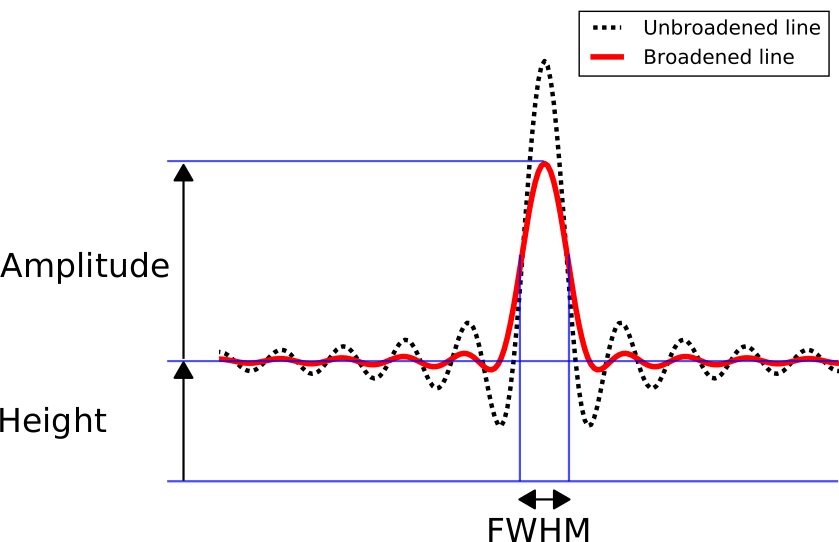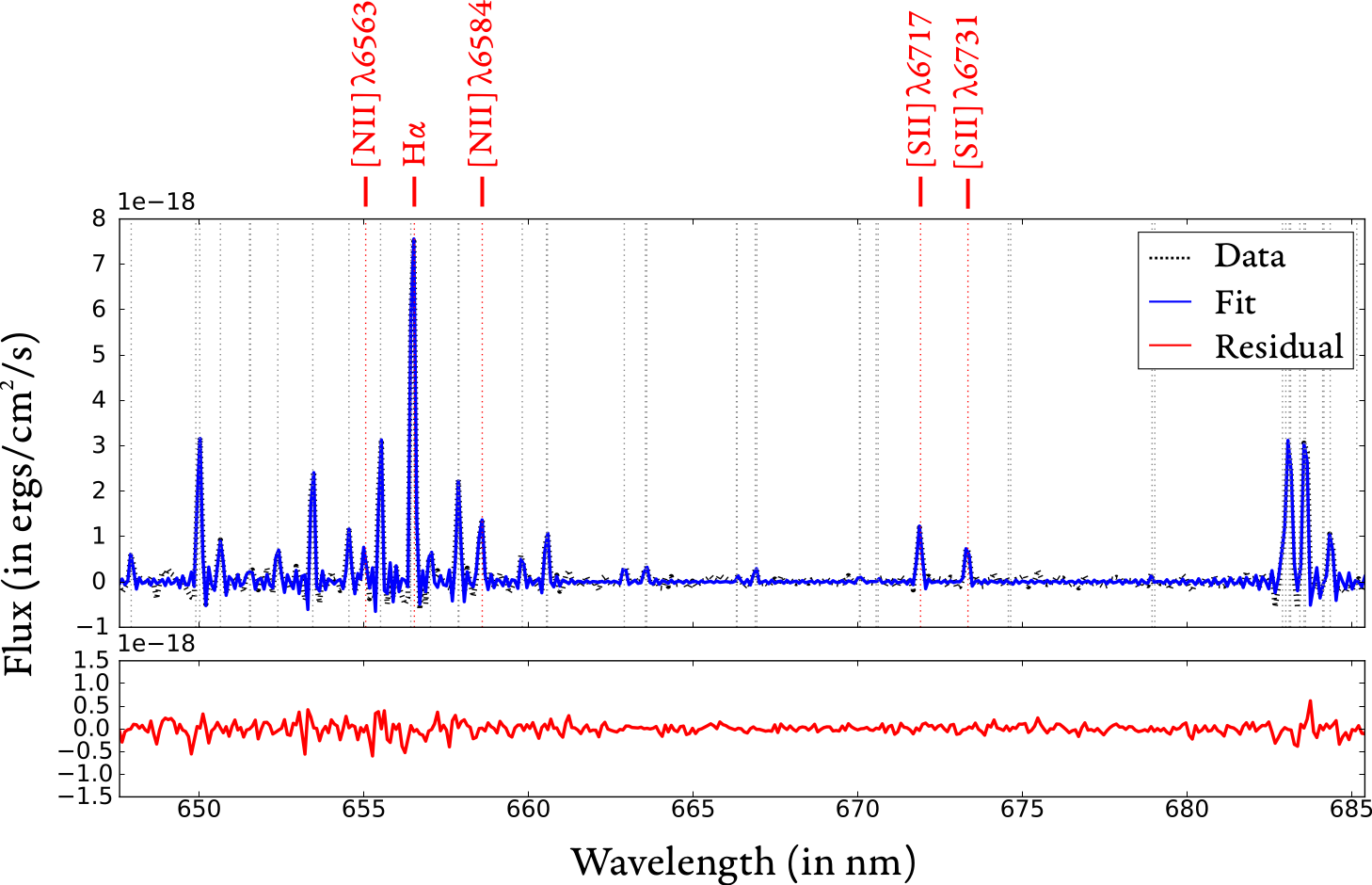Introduction¶
Contents
A few words on ORCS¶
ORCS is a Python module which gives you the keys to the analysis of your SITELLE data cube.
It is composed of calibration methods, extracting tools and a powerful fitting engine specifically designed for interferometric data. When fitting spectra, both a classical (frequentist) and a Bayesian paradigm are available.
The fitting engine¶
Models¶
ORCS ftting engine has been built to accept any number of models (even grid models). Up to now only three models are available (and used by default). They all are implemented and documented in the orb.fit module:
orb.fit.Cm1LinesModel: Emission/absorption lines (sinc convoluted with a Gaussian giving a certain broadening to the sinc)

orb.fit.ContinuumModel: Continuum emission (treated as a polynomial)orb.fit.FilterModel: Filter
Models parameters¶
Emission lines and background model parameters are always defined via keywords which are passed to the fitting functions (see Examples).
Each model is based on a given number of core parameters. In the case
of the lines model those parameters are, for each line, its amplitude
(amp), FWHM (fwhm), position (i.e. its wavenumber of
wavelength, pos) and its broadening (sigma, only in the case
of a sincgauss line shape - this parameter does not apply for pure
gaussian or sinc line shape).
In the worst case all the core parameters are free. But you can also
decide to fix some of them or make them covarying. By default all the
parameters are free but you can change the definition of each
parameter with the keywords: amp_def, pos_def, fwhm_def
and sigma_def. If the FWHM is fixed then you will pass the option
fwhm_def='fixed' to the fitting method.
Let’s start with classical free parameters. Once the behaviour of the
parameters is defined you may want to give it a good initial guess
value (especially for the wavenumber) and start fitting. The initial
guess value can be given with the keywords : amp_guess,
pos_guess, fwhm_guess and sigma_guess. Only the guess on
the wavenumber is necessary as the others have no real impact on the
result or, in the case of the fwhm, they are known a priori with a
good enough precision. The guess on the wavenumber is so important
that it is not an optional keyword and can be specified with the
lines parameter of the fitting method.
The notion of covariation is a little more complex but is certainly
the most useful. two lines can share the same broadening. In this case
the broadening parameter of both lines must be replaced with one
single parameter. You can define the covarying parameter by tagging
them with the same symbol (a string or a number). let’s say you have
three lines (line0, line1, line2), you can group the broadening of
line0 and line2 by passing to the fitting function the keyword
sigma_def=('1','2','1'). The real broadening of the lines used to
model the spectrum will be a function of the initial guess value of
the broadening of both lines (0 km/s by default) which will be fixed
during the fit and the covarying value which is a free parameter.
You can also group the lines with the same velocity. In this case, the
base parameter is the wavenumber of the lines and the covarying
parameter is a velocity. To group the lines having the same velocity
(e.g. line0 and line1 in the example) you must pass the keyword
pos_def=('1','1','2'). The real wavenumber of the lines used to
model the spectrum will be a function of the lines rest-frame
wavenumber (fixed and passed as an initial guess parameter) and their
group velocity. The velocity may be substantially different from 0 and
the value of the covarying parameter must thus be given to compute a
good enough first initial wavenumber of the lines. The value of the
covarying parameter can be passed with the keywords: amp_cov,
pos_cov, fwhm_cov and sigma_cov. If we want to set an
initial velocity of 1500 km/s to the first group of lines and an
initial velocity of 3000 km/s to the second group of lines (which
contains only line2) we must give one velocity per group of
velocities in the order of their appearance in the definition
(here pos_def=('1','1','2')), i.e. pos_cov=(1500, 3000)
These examples are related to the definition of the fitting parameters:

Uncertainties¶
The uncertainties on the returned parameters are based on the assumption that noise distribution is Gaussian and that there are not correlated. I have checked those assumptions by analyzing the distribution of the posterior probability on each parameter with a Monte-Carlo-Markov-Chain algorithm and found that they are very reasonable. The uncertainties returned by the MCMC algorithm are also very close to the one returned by our algorithm (less than a few percents).
List of available lines¶
NAME |
Air Wavelength |
|---|---|
[OII]3726 |
372.603 |
[OII]3729 |
372.882 |
[NeIII]3869 |
386.875 |
Hepsilon |
397.007 |
Hdelta |
410.176 |
Hgamma |
434.047 |
[OIII]4363 |
436.321 |
Hbeta |
486.133 |
[OIII]4959 |
495.891 |
[OIII]5007 |
500.684 |
HeI5876 |
587.567 |
[OI]6300 |
630.030 |
[SIII]6312 |
631.21 |
[NII]6548 |
654.803 |
Halpha |
656.280 |
[NII]6583 |
658.341 |
HeI6678 |
667.815 |
[SII]6716 |
671.647 |
[SII]6731 |
673.085 |
HeI7065 |
706.528 |
[ArIII]7136 |
713.578 |
[OII]7120 |
731.965 |
[OII]7130 |
733.016 |
[ArIII]7751 |
775.112 |